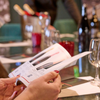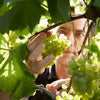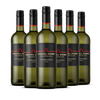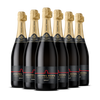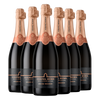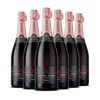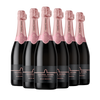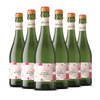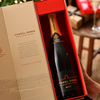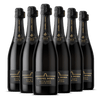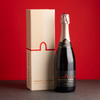Step One: Equipment Set Up
Before we begin, it is important to make sure that your environment is conducive to wine tasting. A relaxed atmosphere is crucial, and a room smelling of baked mackerel probably isn’t great. Try to avoid too much perfume or brushing your teeth immediately prior to the tasting – (unless you are trying to pair a wine with mint). And of course, we drink as we eat – first with our eyes- so ensure good lighting. Not so much that it spoils the mood of course.
Try and ensure you’re using the right sized, clean wine glasses. Although flutes are pretty for sparkling wine, they aren’t ideal for a tasting. The rim is too small to get a good sniff of the wine. And smell is taste. So ideally for tasting all wines, use a glass with a bowl that narrows slightly towards the top. A glass with a big basin is ideal as the narrow top will trap, and therefore concentrate, the aromas as you dive in.
Lastly, remember that the temperature of the wine itself will have an impact on scent and flavour. If a wine is chilled, flavour and aromas can appear muted. Try to make sure that your line up of wines are tasted at the same temperature. As a rule of thumb, take a white wine out of the fridge for 15 minutes before you drink it, and put a red wine in the fridge about 15 minutes beforehand. We tend to drink white wines too cold to get the best out of the flavours, and our red wines too warm. Room temperature is a lot warmer than it used to be! If it’s bad wine – then like mass produced Aussie lager – chill it to as close to freezing as you can get it…. You won’t taste a thing!
Remember that there are no right or wrong answers. Just have fun! To support you in your tasting journey, we’ve provided you with the Chapel Down tasting wheel, as well as a neat tasting form template for recording your experiences.
Step Two: Appearance
Pour the wine into your clean glass and hold the glass against a white background, like a napkin or tablecloth. Slightly tilt your wine glass and try to see its intensity and colour.
White wines can be almost clear, or very pale Lemon-Green, or richer in warmer Gold, or Amber. At Chapel Down our white wines are very pale. Hand harvesting and whole bunch pressing means that very little skin damage occurs to the grapes. Skin contact with the juice can intensify the colour of the wine. Secondly our grapes are grown in a cool climate, which creates wines with a lower pH. The hue of colour in a wine is much more vivid in wines with higher pH. We would therefore describe Chapel Down Bacchus as water white/very pale lemon, whereas Kit’s Coty Chardonnay, due to its fermentation in barrel, is described as pale lemon.
In a similar vein, rosé wines are often described from pale blush and salmon pink, to more intense deep, or vibrant pink. As with our white wines, our rosé wines are generally much lighter than most, with Chapel Down Rosé Brut NV described as very pale pink, whereas, English Rose would be described as pale salmon pink.
Step Three: The Nose
To identify the ‘nose’ of a wine, swirl the liquid within your glass. This will allow some air into the wine and help release the aroma compounds within the wine.
Once the wine settles in the glass, take an exaggerated sniff. The joy of wine is it’s ability to smell and taste of such varied sources, from fruits, to nuts, to spices, to the forest floor. I’ve heard our Bacchus described as “the smell on the edge of a mossy pond after a thunderstorm”. Whatever it triggers, wine can be a wonderful assault on your senses.
Wine aromas at a glance:
• Primary aromas, such as fruit and floral smells, come from the grape variety itself
• Secondary aromas are broadly derived from the winemaking process
• Tertiary aromas develop as wine ages in bottle
Like many of our wines, if the wine is young, it will generally have a fruity aroma. For instance, primary notes of melon and green apple appear in Bacchus. If the wine is older, it will have a deeper, more earthy smell, like that of grass or oak. Take your time to enjoy the aromas.
A good example of a secondary aroma is within our Kit’s Coty Coeur de Cuvée 2015. Shortbread aromas are derived from the yeast of wild fermentation, and the maturation in French oak for seven months, before release.
Step Four: Palate
It’s hard to begin with, but keep practicing and you’ll detect primary, secondary and tertiary flavours not only on the nose, but also on the palate. Swish the wine around your mouth and suck in some air if you dare (although that’s getting a bit winey!) – and then swallow it (or spit it out depending on how much you’ll be tasting). Breathe in. Now focus on the sensation and taste in your mouth. Think about it’s body and weight. It can be thin and light, or heavy and rich. Look out for the mouth-watering feeling of acidity in your gums. The different levels of acidity, sweetness and tannin, combined with the wine’s general body contribute to structure. To support you in your tasting analysis, please click here for the Chapel Down wine tasting wheel.
You are also likely to notice the texture difference of bubbles in sparkling wines, depending on how the wine is made. For example, our Brut NV is made through the traditional method. Therefore, the bubbles are likely to be more fine and persistent when compared to Bacchus ‘with a touch of sparkle’, which is a lightly carbonated wine.
Within this section of the tasting, you should also consider the finish of the wine. This is the sensation you receive once you’ve swallow the wine. This can vary from the initial taste that you experience when the wine first enters your mouth. The sense of texture also builds the finish profile. Common Terms: Plush, Round, Velvety, Supple, Opulent, Mouth watering, Clean, Fresh, Voluptuous, Creamy, Buttery, Lush, Soft, Silky, Spineless, Flabby. I use a lot of these words to describe wine bores too…
Also, think about the “length” of the wines. Ask yourself, how long does it take until the wine flavour has finished lingering in your mouth? A long finish is often taken as a sign of quality.
Step Five: Conclusion
The final step of the wine tasting is to conclude. This step is urging you to draw a general judgment of the wine. Actually in my experience, the final step is to decide which one you want to drink again! There are NO rights and wrongs in your decision and don’t listen to wine snobs. Ever! If you like it, you are right!
Your final judgement is influenced by all stages of the tasting process – the appearance, the nose and the palate. And perhaps the price too. So here’s some great deals for you to have fun with friends. Just ditch the wine snob first.




